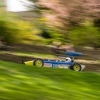Appealing to the historians among you wonderful bunch. I've acquired this original photo, photographer Hugo Rudolphy who I am aware was based in Berlin in the 1890's. The seller listed it as 'probably 1930's' but it's clearly much older. If anyone has an idea of the car, location driver(s) I'd be grateful! I think it might be a Mors but I'm not great on these old machines. Many thanks!































